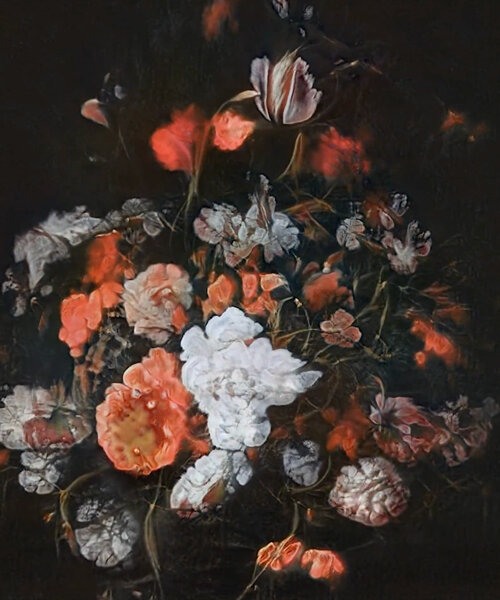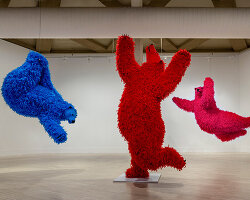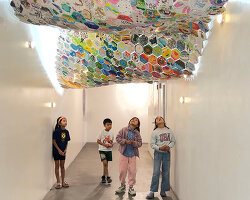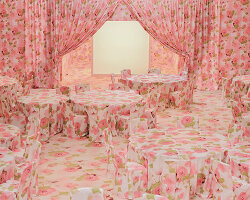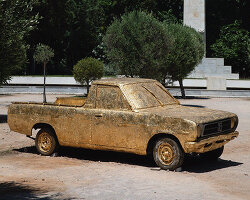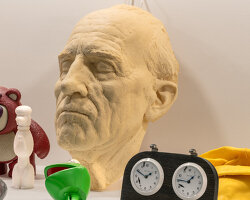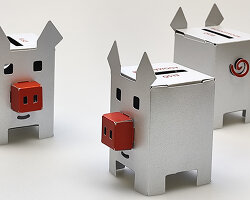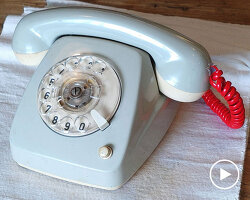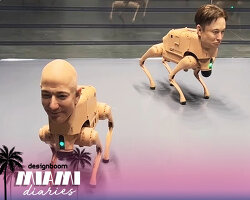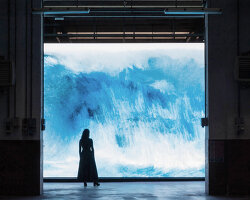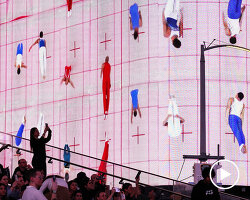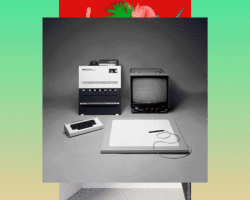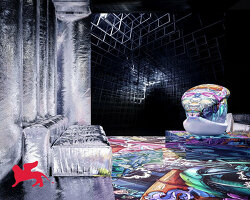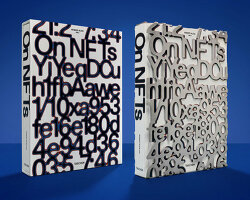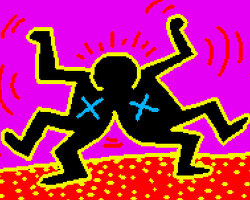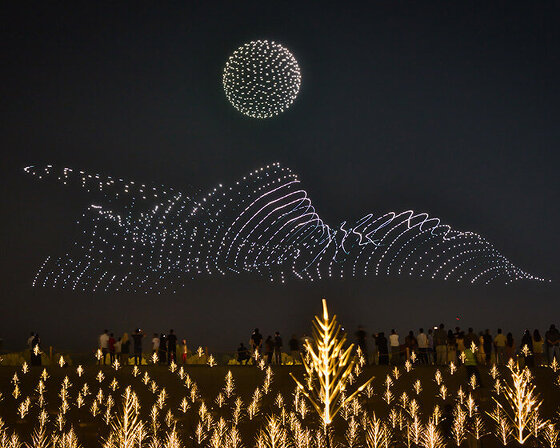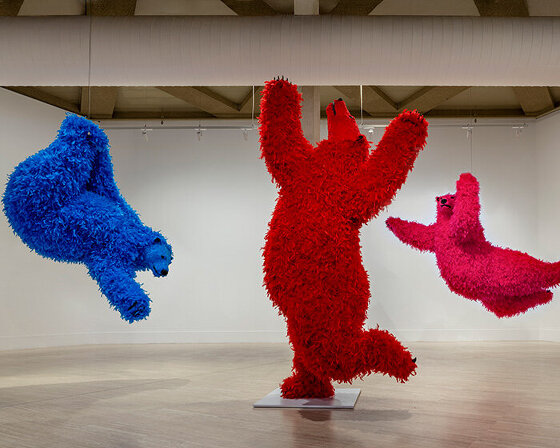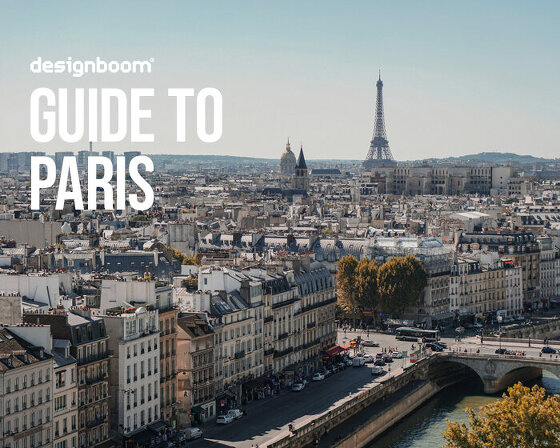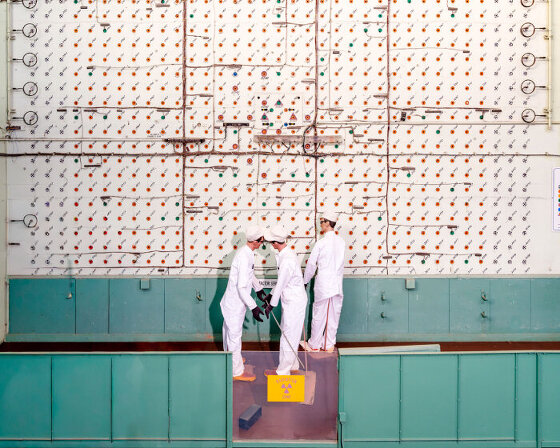PIONEERING ART IN DIGITAL MEDIA
Founded in 2015, Daata is a digital art incubator that curates, commissions, exhibits and sells original, digital artworks by emerging and established international artists. A pioneer of art in digital media, the platform has commissioned more than 400 artworks by over 100 artists to date, and collaborated with galleries, museums, collections, art fairs, festivals and other organisations such as NASA, Kiasma, MOCAD, Art Basel, Phillips, Hauser & Wirth and kurimanzutto among many others. With an interest in supporting artists that realize artworks bridging digital and physical media, Daata’s projects are often multidimensional, spanning from image and video NFTs, to physical installations and objects.
designboom spoke with founder, David Gryn, and web3 strategist and chief technology officer (CTO), Josh Hardy, to learn more about Daata’s mission, their view on AI tools and how digital media is disrupting the art world. ‘My role has been to work with artists who work with technologies like artists who work with tubes of paint,’ notes Gryn during our interview. ‘The best artists always get the best out of technologies. It doesn’t make you a good artist because you’ve got the best tools in your hand. That’s always been the mythology, that the tool will actually make you a good artist. It’s never done that to anybody.’ Read the conversation in full below.
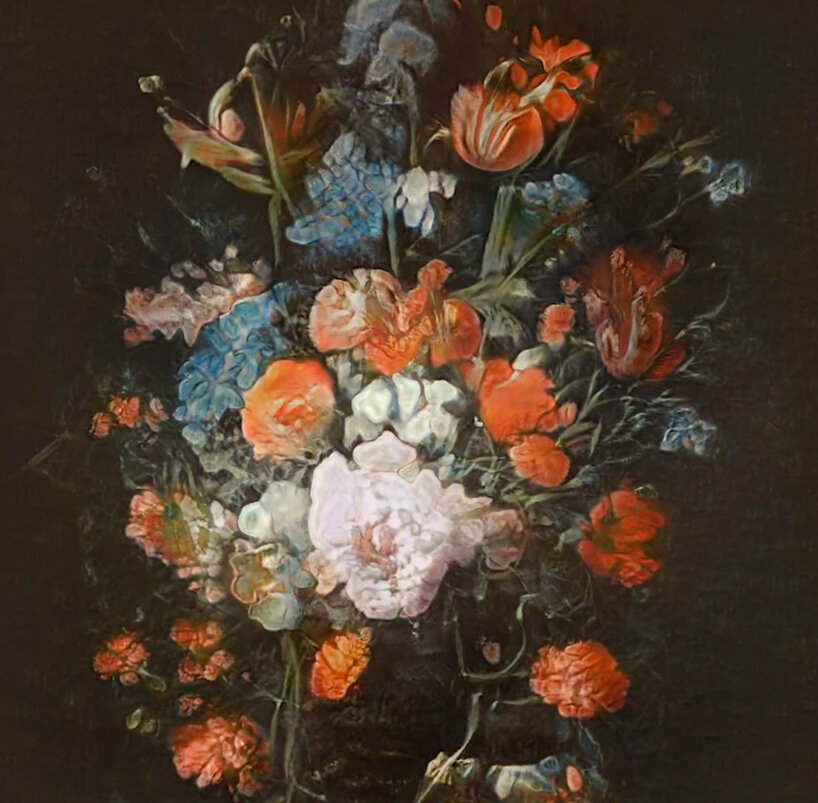
still from Damien Roach, SEED TWO (ii), 2022 | AI-generated video with sound, NFT | courtesy the artist and Daata
INTERVIEW WITH DAATA’S David Gryn AND Josh Hardy
designboom (DB): Can you introduce Daata’s mission? Do you collaborate with artists directly or through other galleries? How do you select who to work with?
David Gryn (DG): Daata started as a commissioning platform for artists working with digital media, ostensibly video and sound works, mp4, mp3. Our mojo always has been, even to this day, how do we empower and support artists working with certain technologies? We started with commissioning, paying artists some fee to make their work, making sure they got paid a royalty on sales, and finding ways to promote it in the market with outcomes beyond just the website, like doing physical events. I have a background in curating, facilitating projects with fairs like Art Basel and encouraging galleries and artists to show their digital work when they wouldn’t normally bring it to an art fair. I’ve been doing this for 20 years and we launched as Daata effectively nine years ago. In my time of doing this we’ve commissioned about a hundred artists, we’ve got a lot of galleries we work with while often collaborating with museums and art fairs.
I’ve always hoped that there was going to a bigger marketplace and that there would be more than a couple of platforms that were doing what I did and what we’ve done. Now we’ve got this tsunami of platforms and it puts us into a very interesting place. This possibility brings almost a hyper excitement as opposed to before, when we were trying to get people excited just to have one person looking at a video. Expectations have changed, everything’s changed in the last two years and even we had to recalibrate. We weren’t a tech platform when we launched, we were a website that was built by very close partners to us who had the technical abilities to build a website that we could show videos on, but we weren’t techies. Josh (Hardy) joined us, took over the website, and has built our abilities to do projects with NFTs, augmented reality, and all the things that we realized we had to make sure we could do before we could breathe. Everyone was approaching us to work with them but we still didn’t feel that we were in the perfect place just because we had artist artworks and content. We didn’t want to just be saying yes to everybody just to help their business model. We probably should have done some yeses, more than nos, but it was the way that we felt we could believe in what we are doing and trust the process, not just for ourselves, but for the artists we represent and work with.
DB: Although some platforms, like yours, have been around for quite a few years now, this moment feels really fresh and exciting for digital art. Like somehow things are really just starting now.
DG: It’s one of those times where you just know that you have to take a deep breath, recalibrate and not be scared of it. Change is often scary to people, but I think the nurturing of an artist is always about the nurturing of something that will change all the time, because that’s what artists do. We have to be a platform that can support that but also breathe with it too and be able to change alongside the artists we work with. But they also want to know that we are going to be a strong platform and protector to them too. So it’s about how we move forward together, while new artists come along. We’re currently talking to artists who are literally in their early twenties, doing brilliant work and we’re recognizing that. They are coming tuned in with technologies that someone possibly in their thirties, forties, or fifties might not have.
We are seeing something very new and exciting, things like AI and VR just weren’t around. Those that have grown up with these really have a different understanding. It’s a bit like going to Western City or going to see ceramics somewhere like in Tokyo or Kyoto. You realize there’s a different appreciation of that matter because it comes from somewhere that believes and trusts in that material in such a different way to how we have been brought up. In a way, that clock has gone so fast with digital, whereas it took maybe thousands of years with ceramics.
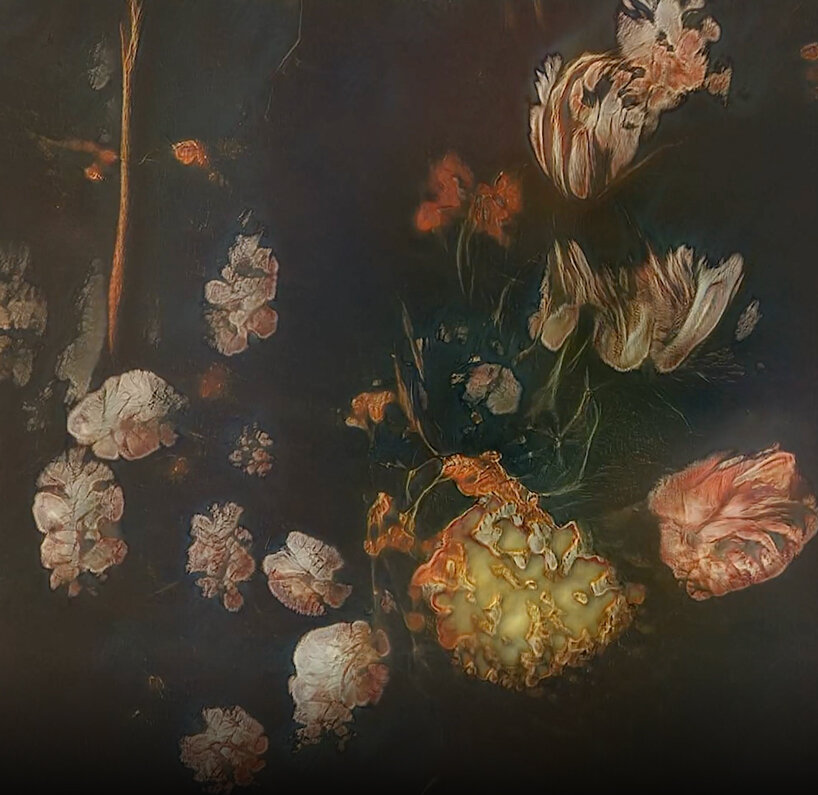
still from Damien Roach, SEED TWO (ii), 2022, courtesy the artist and Daata
DB: Are you interested exclusively in the digital sphere or are there physical extensions of what you are doing?
Josh Hardy (JH): Actually ‘Seed’, the project we just launched with Damien Roach has a physical component. It mainly consists of NFTs, which are videos generated from an AI model that he trained on 17th & 18th Century Dutch flower paintings in 2020.
DG: He’s a musician, so he also came up with a soundtrack featuring the sound of an orchestra. The series is offered in tiers that include five unique NFT videos accompanied by five unique skate decks produced in partnership with legendary UK skate company, ISLE; an edition of 55 unique animated NFTs, each paired with a limited edition perfume reframing Trackside Buddleia, an artisanal fragrance produced by perfumer Ezra-Lloyd Jackson; and 55 unique T-shirts each featuring a unique AI-generated still life from the project. Merchandise is embedded in some of the things we do with artists because it adds a sort of repertoire and dialogue around the work. It’s not the logic of just merch, it’s more the feeling of the NFT world and the idea of being able to own things. Not just to those that can afford maybe the more expensive things, but enabling also other kinds of ownership. It’s not really lucrative, but it’s part of the narrative. Actually most artists we work with get really excited about merchandising. I think they see the pop world and they think it’s the same thing. It isn’t, there’s such large audiences with the pop world. Even at the top end of the art world, you don’t have that level of interest. You don’t have millions and millions of followers of any particular art form, people might be aware, but I can’t see an equation. Maybe with the music world when it’s at top level.
JH: I just think things get disrupted by technology. Every industry gets disrupted, and in a way I think it’s the art world’s reckoning with the internet and technology. It didn’t work before, but solving the ownership problem for digital files meant that you could distribute art and when you can have that scale of distribution then naturally you start thinking, well, if we can distribute to a lot more people we can lower the price. So the vertical thinking about the art world, where some people sit up here and then everyone else down there just gets to walk into a gallery and pay to go see some things on the wall, is flipped on its side all of a sudden. It’s much wider and everyone can get involved and participate. It’s maybe not so elitist.
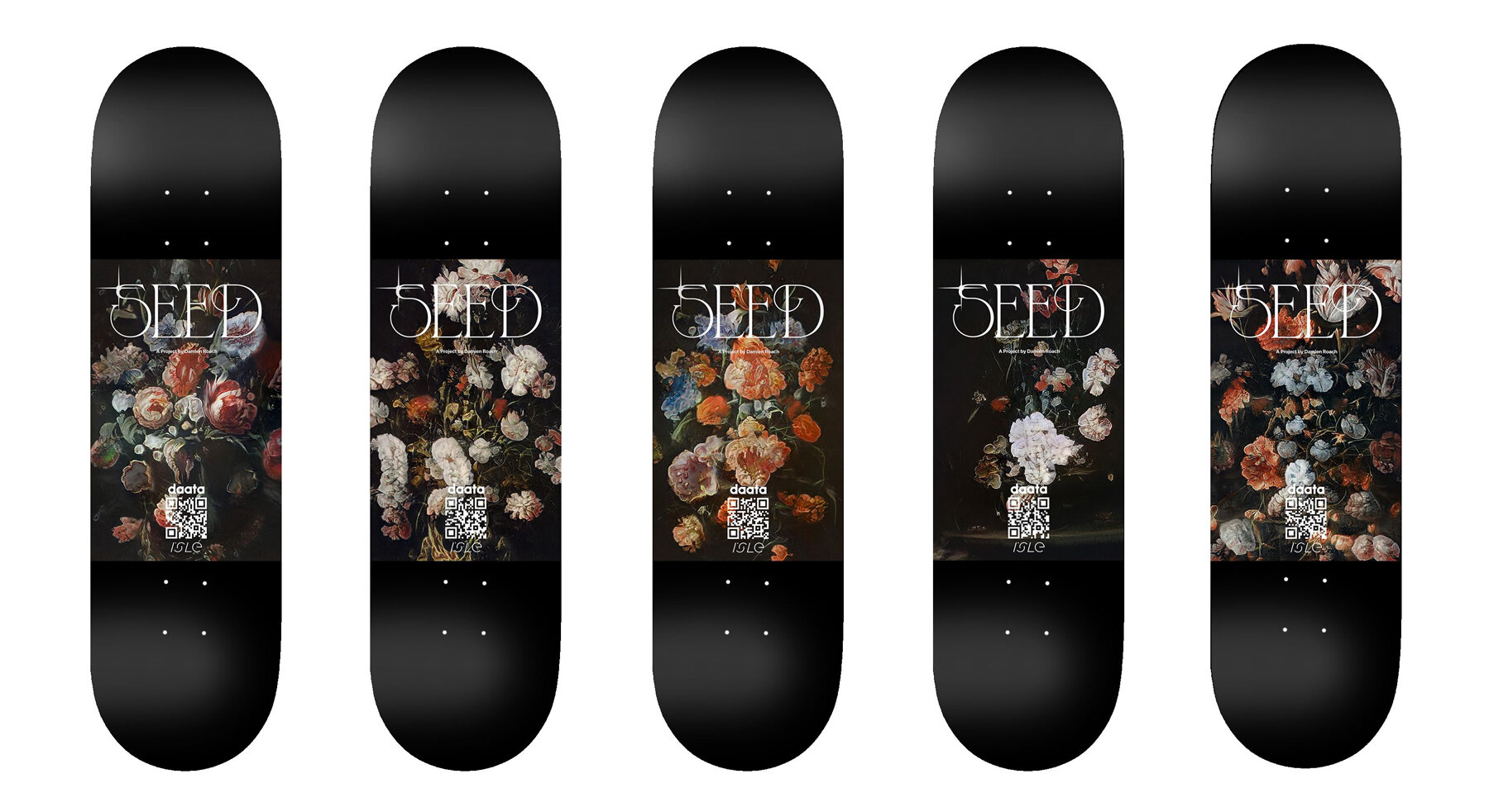
the first purchaser of Damien Roach’s SEED TWO NFT receives a unique skateboard deck printed with a one-of-a-kind graphic
DB: I also think it’s a chance to introduce a lot of different artists that didn’t have a chance before. It’s definitely opening a whole new universe.
JH: That’s exactly what happened to music about 20 years ago. Online basically disrupted the whole music industry and then it disrupted it again. First of all it disrupted it because suddenly musicians didn’t have to rely on certain gatekeepers to get access to the market. So they didn’t have to say, oh, if someone from NME or whatever, doesn’t give you the tick of approval you can’t get in front of people. They could just put it up on their MySpace page. There was a whole wave of new musicians that got big off being able to have direct access to their fans. That was the promotional disruption, and then there was the distribution disruption, which happened around the same time and happened multiple times with PTP file sharing and then iTunes and then streaming after that. Spotify didn’t have the deals, they actually started streaming music before even having deals with the labels. And then they went to labels and were like, well you don’t have choice, because either you make a deal with us and we do it legally or someone else is gonna do it illegally. We’re already doing it and getting traction so you can make a deal with us now. Anyway, the point is technology disrupts things, and I think that’s what’s happening again now.
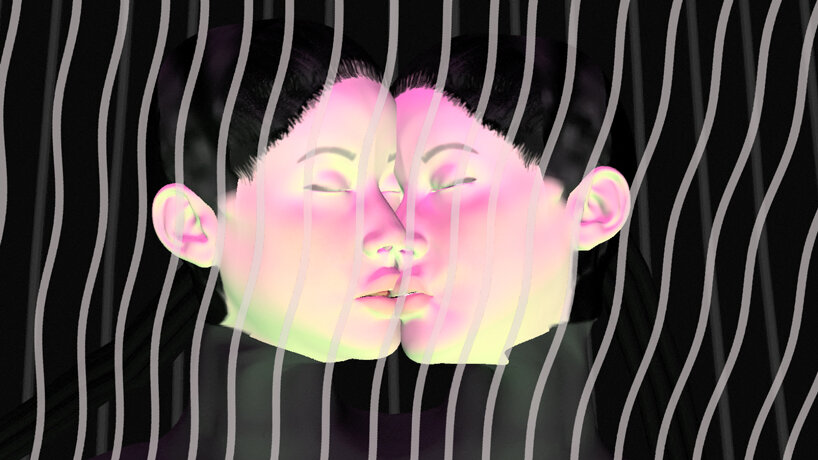
Trulee Hall, Two Heads, Two Ways, 2020 | still from HD Video, NFT 00:08:14 | edition of 8 | courtesy the artist and Daata
DB: Speaking of AI, at designboom we have featured plenty of AI-generated works in the past few months. Do you have an opinion or understanding of how ownership rights work with these artworks? There has been a lot of discussion about using precedents and images from other artists.
DG: Copyrights have never really been a concern of mine. Forget technology now, in the 20 years I’ve worked with artists working with film, some of the best ones have stolen work and ideas. Unless it is pure robbery and the whole artwork is somebody else’s, which of course is wrong. Once I asked Christian Marclay, a brilliant artist and musician, about that and he just said he probably wouldn’t be able to make an artwork if he worried about copyrights.
He made this magnificent work called The Clock, a 24-hours long installation featuring thousands of film and television images of clocks, edited together so they show the actual time. It’s just one of those things where you are watching and go, ‘why hasn’t anyone done that before?’. But he wouldn’t have been able to make that film if he worried about copyrights. It is basically 24 hours of stolen footage.
JH: That said, in music, sampling is massive and there are whole parts of the industry which are dedicated to pursuing and defending copyrights.
DG: In my view, which has always been about popularity, once we get to a place where there’s big wealth potential with anything you do, people start worrying about copyrights. They haven’t worried about it before because there was no revenue model attached, or it was very limited. So if you’re selling a big work by Christian Marclay, you’re selling that to maybe some museums, that’s like maybe a few editions, there’s never been a mass business model that everyone can see. And I think now that changes the conversation. And again, blockchain can serve that pretty well if it’s managing itself well.
JH: The AI thing is interesting though, there’s a separate issue, which is these AI models that are trained on other people’s work. If you use that AI model you are using their work, it’s just not directly. It’s more obvious with Damien because he trained his model on a very specific thing. But it’s less obvious if you’re using DALL-E or Midjourney because they’ve been trained on so many different things. I don’t think anybody knows exactly where the references are coming from for any particular image. It’s almost like an impossible thing to prove. In music it’s clear, there are certain boundaries. They say that if you use more than three notes in a melody, then you can say that it’s copied. But if it’s just three notes, they don’t constitute enough of an idea to be even stolen.
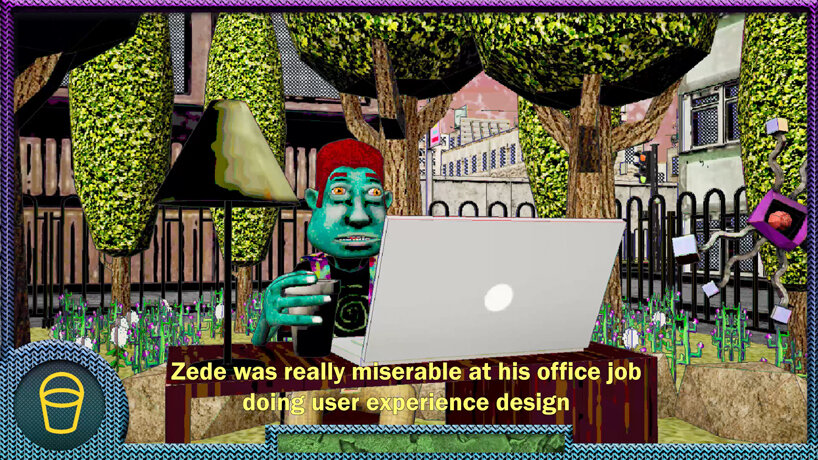
Jeremy Couillard, There is No Up Or Down, Only Attraction, 2022 | still from 4K Video, 00:03:23 | edition of 8 | courtesy the artist and Daata
DG: I was at a talk a few years ago, before there NFT craze, and there was a panel of all these quite wealthy individuals, all talking about their brilliant new art businesses and talking about AI and how it’s going to make the artist obsolete. And I thought, making the artist obsolete because you’ve got some technology that puts the artist out of a job? That’s when it goes nuts, when people start thinking that you can replace the artist. When the artist wants to use it to make a great work, then I’m happy as Larry for that. I don’t have any problem with technologies if the artist is using them.
JH: There’ll be a bunch of people that make art with AI that is just crap and no-one would consider art, and then there’s going to be an amazing AI artist, who has used it in such a unique way that nobody else can replicate. You’ve got your own style, your own perspective and you’re using a tool to illustrate that perspective.
DG: My role has been to work with artists who work with technologies like artists who work with tubes of paint. The best artists always get the best out of technologies. It doesn’t make you a good artist because you’ve got the best tools in your hand. That’s always been the mythology, that the tool will actually make you a good artist. It’s never done that to anybody. It literally is like an amateur dentist with a drill, you don’t want them doing your teeth at all. It’s no different to me, but the artist is always treated as the proverbial amateur. I had a talk last week with people doing research for Meta and they were asking about all these different tools artists could use, and I said I don’t mind anyone having the right, good tools, but I don’t care for amateurs to have the best tools because they’re still going to be amateur artists. It’s great that it empowers people to play with their hobbies, but you actually want the best artists to have the abilities, the time, space, and money to make work. If you can provide them with the best tools, they’re going to do great things.
Now with the NFT space there’s so much quality-looking work, but you’re not sure whether it’s good or not because you don’t really know who the artists are sometimes. It’s about seeing through the skills of others to be able to narrate and communicate what is quality and what’s not. We have to think slightly differently about who the interesting artists are and what is an interesting artwork. There’s been such a shift in two years, I’ve never seen such a big change. I’m not a techie but I’ve been involved with digital media for nearly 40 years, and I really haven’t seen anything like this before. I saw the change from non-online to online, and it was very obvious, but it was something that lots of people resisted. I was doing some project and the newspaper proprietors were going like, ‘oh, we’ll never be online’, and the next year, the Guardian and the BBC were online. You could see that shift was coming, but I’ve never seen such excitement as now. Soon you’re going to have the people who start life at art schools and growing up with these technologies, when it was never a possibility to even be considered a good artist using those technologies until the last five or ten years.
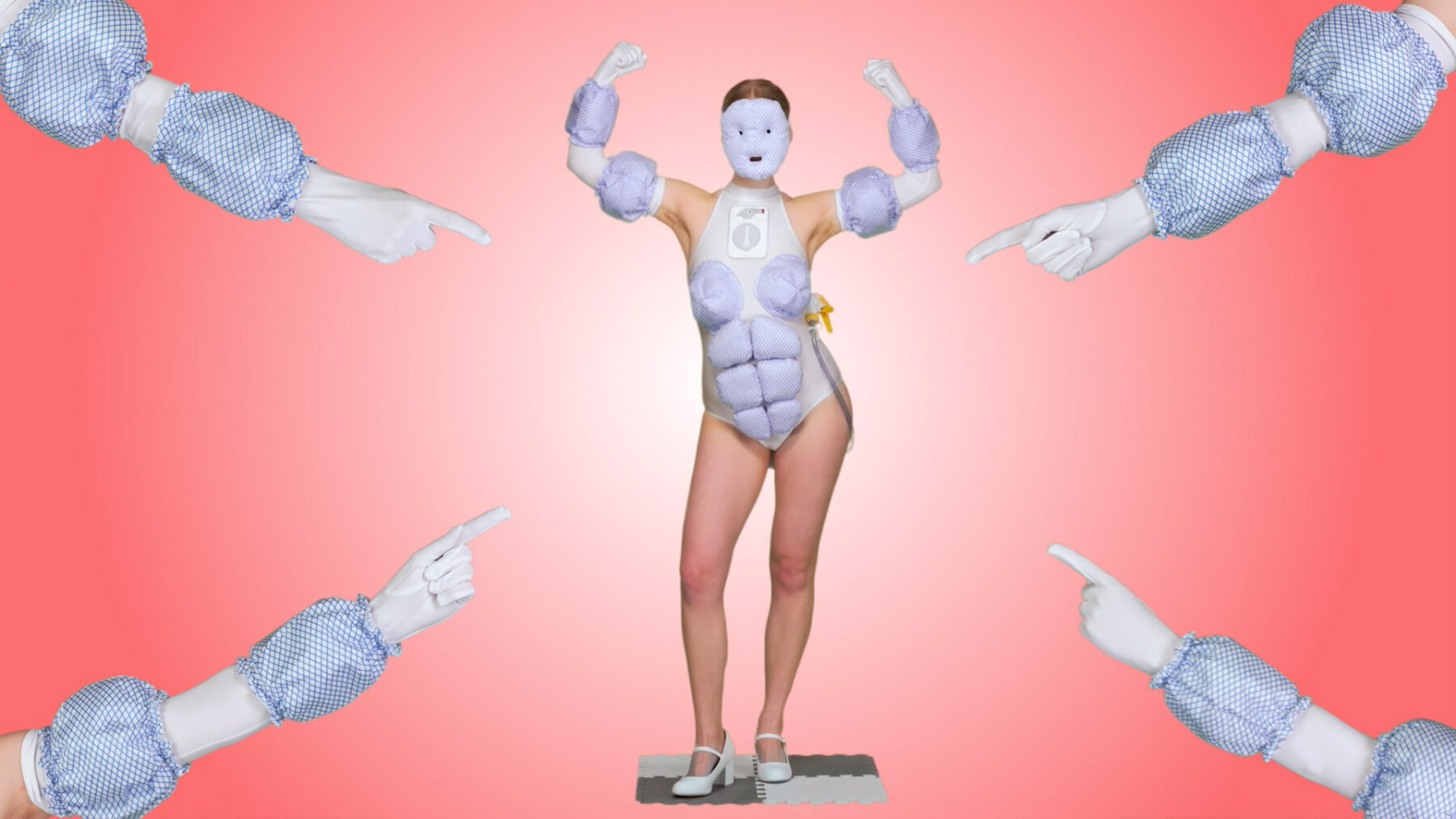
Rosie Gibbens, The New Me: Super stylish and efficient cleaning outfit, 2022 | still from HD Video, 00:02:10 | Edition of 8 | courtesy the artist and Daata
DB: What else are you working on at the moment?
DG: We’ve got quite a few interesting projects that are in gestation. We are working very closely with a group of artists called Keiken, they are three female artists who are completely immersed in new technologies but also do installations. I can’t say too much, but it involves AI, NFTs, the Metaverse, VR. We’re working with some interesting partners on this. Then we also have a regular relationship with KOKO, the London venue, and next month we’re doing a takeover of their shop. It will be full of all the physical objects we’ve created and the possibility to view and purchase the NFTs as well.
It’s interesting, it just almost feels like there isn’t a moment to really breathe, so we tried to take the last year to breathe and make sure we are doing things the way we want to, including how we care about artists.
We are getting to that point where we are pretty clear about it. Sometimes it takes time, some people are much quicker to make a lot of money out of things or to move really quickly. We didn’t want to just jump in deep water and work out how to swim. It was tempting and I think we now feel very confident that we know where we’re going. It feels like it’s a hugely positive and exciting time and we are now starting to connect with people who’ve done brilliantly in it, people who are emerging, and some who are new to it.
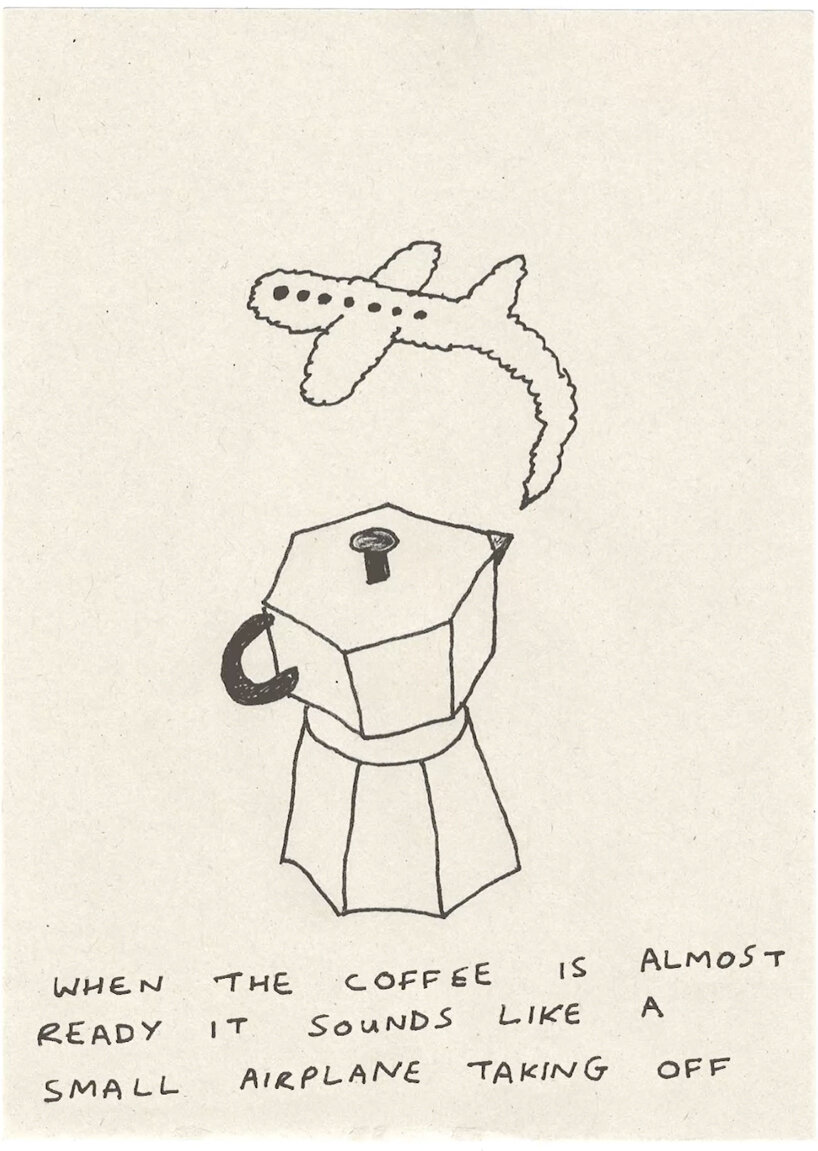
Orfeo Tagiuri, Takeoff, 2022 | still from hand-drawn animation, NFT 00:00:02 loop | edition of 20 (first buyer of each edition receives a unique drawing) | courtesy the artist and Daata
DB: Can you tell me about the Daataverse membership NFT?
JH: We did talk a lot about doing a token, but then we decided instead to do an NFT. There’s only 500 in existence and the idea is to have an access pass to the Dataverse, both online and IRL. So, if we show at an art fair, then the Daataverse NFT may get you one of our VIP passes to the fair Or if we do events, you’ll get an automatic invite to the events. Then the same goes for online, we have a Discord and there’s a token gated section where you can get extra alpha, information about presale and drops we’re doing, as well as early access to drops.
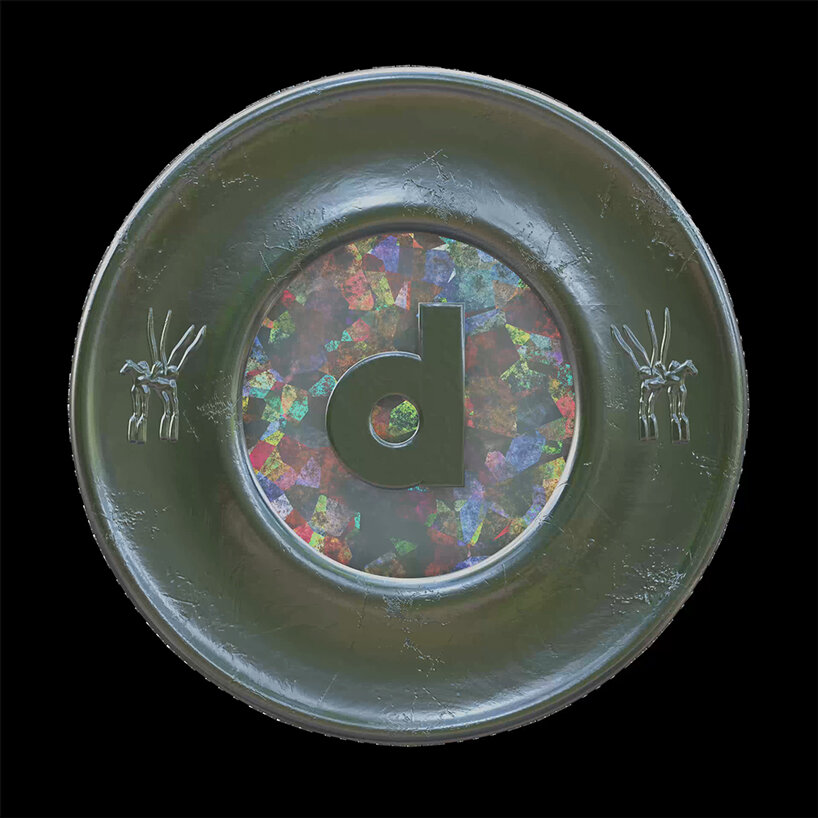
Daataverse Membership NFT 1, designed by Keiken | courtesy the artist and Daata
